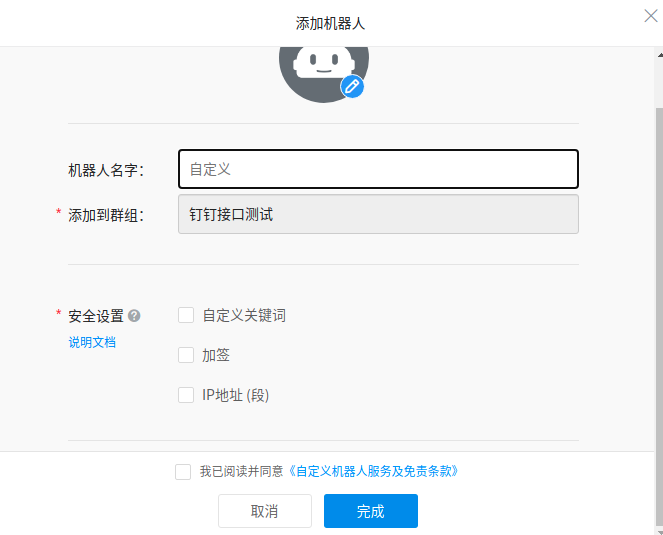调用钉钉API发消息
一、自动获取access_token
#!/usr/bin/env python
# -*- coding: utf-8 -*-
# 2017-8-20 钉钉API发送消息
import urllib, urllib2
import requests
import json
import os
import sys
'''
钉钉管理后台 : http://open-dev.dingtalk.com
CorpId : 企业应用ID
secrect : corpSecret管理列表下面 企业应用的凭证密钥
'''
corpid = ''
secrect = ''
#获取access_token
def getToken():
url = 'https://oapi.dingtalk.com/gettoken?corpid=%s&corpsecret=%s' % (corpid, secrect)
req = urllib2.Request(url)
result = urllib2.urlopen(req)
access_token = json.loads(result.read())
return access_token['access_token']
#默认情况下第一次创建群组 并获取群组id chatid并写入文件里
def getChatid(access_token):
file_name = "/tmp/.chatid"
#判断群组id文件是否存在
if not os.path.exists(file_name):
url = 'https://oapi.dingtalk.com/chat/create?access_token=%s' % access_token
'''
name : 群组名字
owner: 群主userid
useridlist: 群成员userId列表 也可以写群主userid
'''
data = {
"name": "test1",
"owner": "manager302",
"useridlist": ["manager302"]
}
data = json.dumps(data)
req = requests.post(url, data)
chatid = json.loads(req.text)['chatid']
with open(file_name,'w') as fd:
fd.write(chatid)
else:
with open(file_name) as fd:
chatid = fd.read()
return chatid
#access_token 访问令牌 chatid 群组id content 发送的内容
def tonews(access_token, chatid, content):
'''
chatid : 群组id
msgtype : 类型
content : 内容
'''
url = "https://oapi.dingtalk.com/chat/send?access_token=%s" % access_token
msgtype = 'text'
values = {
"chatid": chatid,
"msgtype": msgtype,
msgtype: {
"content": content
}
}
values = json.dumps(values)
data = requests.post(url, values)
errmsg = json.loads(data.text)['errmsg']
if errmsg == 'ok':
return "ok"
return "fail: %s" % data.text
if __name__ == '__main__':
access_token = getToken()
chatid = getChatid(access_token)
content = '\\\\\\\\n'.join(sys.argv[1:])
if not content:
content = '测试'
print tonews(access_token, chatid, content)
二、手动配置access_token
1、创建群聊
2、添加群机器人




# !/usr/bin/env python3
# -*coding:utf-8 -*-
import datetime
import json
import urllib.request
# 你的钉钉机器人url(Webhook对应的url)
my_url = "https://oapi.dingtalk.com/robot/send?access_token=123asefasdrqwer12341241sadfaserfaer12312341234"
def send_request(url, datas):
# 传入url和内容发送请求
# 构建一下请求头部
header = {
"Content-Type": "application/json",
"Charset": "UTF-8"
}
sendData = json.dumps(datas) # 将字典类型数据转化为json格式
sendDatas = sendData.encode("utf-8") # python3的Request要求data为byte类型
# 发送请求
request = urllib.request.Request(url=url, data=sendDatas, headers=header)
# 将请求发回的数据构建成为文件格式
opener = urllib.request.urlopen(request)
# 打印返回的结果
print(opener.read())
def main():
my_data = {
"msgtype": "markdown",
"markdown": {"title": "123",
"text": " "
},
"at": {
"isAtAll": True
}
}
my_Copywriting = '## 123 \n %s' % '12312312312'
# 把消息内容写入请求数据中
my_data["markdown"]["text"] = my_Copywriting
# 发送消息
send_request(my_url, my_data)
if __name__ == "__main__":
main()
博客内容仅供参考,部分参考他人优秀博文,仅供学习使用





【推荐】国内首个AI IDE,深度理解中文开发场景,立即下载体验Trae
【推荐】编程新体验,更懂你的AI,立即体验豆包MarsCode编程助手
【推荐】抖音旗下AI助手豆包,你的智能百科全书,全免费不限次数
【推荐】轻量又高性能的 SSH 工具 IShell:AI 加持,快人一步
· 开发者必知的日志记录最佳实践
· SQL Server 2025 AI相关能力初探
· Linux系列:如何用 C#调用 C方法造成内存泄露
· AI与.NET技术实操系列(二):开始使用ML.NET
· 记一次.NET内存居高不下排查解决与启示
· Manus重磅发布:全球首款通用AI代理技术深度解析与实战指南
· 被坑几百块钱后,我竟然真的恢复了删除的微信聊天记录!
· 没有Manus邀请码?试试免邀请码的MGX或者开源的OpenManus吧
· 园子的第一款AI主题卫衣上架——"HELLO! HOW CAN I ASSIST YOU TODAY
· 【自荐】一款简洁、开源的在线白板工具 Drawnix